#southwest scotland
Text
me being irrationally annoyed every time i see that water post about the two hour drive comment. i know its hyperbole to be funny i know england is small. i know im being autistic about it. But
7 notes
·
View notes
Text
Where can I find Free Palestine protests and Ceasefire protests?
A super international and continually updated list of actions can be found at Samidoun: Palestinian Prisoner Solidarity Network's:

Calendar of Resistance for Palestine 2024
They list events by date, then alphabetically by country, then by city - and it's common for them to have dozens of actions listed for a single date, especially on the weekends.
The United States especially often has 40+ events on a single day, especially on the weekends.
Events are posted with links to the event info posted by whoever's hosting the vast majority of the time.
Look blow the read-more for a list of many of the countries that have been on this protest calendar, in alphabetical order, since I know so many websites/lists of actions are country-specific
*Obviously this isn't the only good source of listings for protest events - there are many others. This is by far the biggest/most international roundup I've found, though, so I started with this. If you know another good place for finding ceasefire protests/events, please feel free to add it in the notes, bc I'm planning to put a bigger roundup together once I find enough other sites
Countries that Samidoun has listed/does list protests for include (in alphabetical order):
North America:
United States
Canada
Mexico
Puerto Rico (listed separately in anti-colonial solidarity)
Hawai'i (listed separately in anti-colonial solidarity)
Europe:
Austria
Belgium
Bulgaria
Denmark
England
Finland
France
Germany
Greece
Hungary
Iceland
Ireland
Italy
Netherlands
Norway
Portugal
Romania
Scotland
Serbia
Spain
Sweden
Switzerland
Wales
SWANA Region (Southwest Asia/North Africa)*:
Bahrain
Iraq
Jordan
Kuwait
Lebanon
Palestine
Tunisia
Turkiye (Turkey)
*Samidoun notes that "We know that these events are mainly international and that the Arab people are marching everywhere for Palestine – we will be honored to add more Arab events whenever we are informed!"
Asia:
Bangladesh
India
Indonesia
Japan
Malaysia
Maldives
Pakistan
South Korea
Africa:
Kenya
Mauritius
Nigeria
South Africa
Tanzania
Tunisia
*Duplicating North African countries (well, Tunisia) here from the SWANA list btw
South America:
Brazil
Colombia
Chile
Peru
Venezuela
Australia and Oceania:
Aotearoa (New Zealand)
Australia
#reminder that “palestine” and “cw war” are the tags for all of my posts related to palestine#and that I only post relatively positive news about progress toward peace and resistance actions and the like#btw do NOT mess around in the notes with islamophobia OR antisemitism#neither are even remotely acceptable#palestine#cw war#free palestine#free gaza#israel#middle east#gaza#palestinian genocide#genocide#cw genocide#nakba#second nakba#ceasefire#palestine genocide#ceasefire now#palestine protest#gaza protests#gaza strip#gaza genocide#war crimes#ethnic cleansing#colonialism#anti zionisim
3K notes
·
View notes
Text

I’m reading this book at the moment, and did you know that shepherds had their own counting system in parts of Northern England, Wales and the Scottish Borders?
“… let’s start with a little known, deliciously quirky, remnant called the 'shepherds' score', or Yan Tan Tethera. It’s an ancient way of counting, still used by some shepherds today, in northern England, Wales, parts of the southwest and lowland Scotland. The system is vigesimal, or base-20. It stops at twenty - once a shepherd had counted to this number, he’d mark it in some way (a notch on his crook, perhaps, or a stick placed in the ground) and then start again at one.
Linguistically, its origins are lost, but some scholars believe it may have its roots in Brittonic (or Brythonic) languages, those early versions of Welsh, Cornish and Breton spoken during the Iron Age. Individual words vary slightly from region to region, but they all share remarkable similarities. The Lincolnshire version goes like this:
Yan (1), Tan (2), Tethera (3), Pethera (4), Pimp (5), Sethera (6), Lethera (7), Hovera (8), Covera (9), Dik (10), Yan-a-dik (11), Tan-a-dik (12), Tethera-dik (13), Pethera-dik (14), Bumfit (15), Yan-a-bumfit (16), Tan-a-bumfit (17), Tethera-bumfit (18), Pethera-bumfit (19), Figgot (20).
The numbers above ten use a combination of smaller digits - so eleven is Yan-a-dik (one and ten) - it's brilliant in its simplicity and rhythmic bounce when spoken aloud.”
— A Short History of the World According to Sheep, Sally Coulthard, p. 68
#fibre crafts#linguistics#Yan tan tethera#this books has some very interesting sections#would recommend if you do wool based crafts
6K notes
·
View notes
Text
A LIST OF HISTORICAL FIGURE RPF I WANT IN TMAGP.
(This is post is also written from the point of wanting these figures and their stories in the Magnus Archives universe. Trying to keep in line with the historical contexts and figures in TMA, so most are British, except one because it's crazy to me.)
Jeremy Bentham
This whole post is inspired by how absolutely crazy it is that Jeremy Bentham is not in the original TMA series. YES, I get it was to allow Robert Smirke's architecture be front and center to the TMA plot, but I still think it is criminal. He is briefly mentioned in MAG 41 because of reasons I will explain, but briefly mentioned is not enough.
Quick rundown of this dude for those unaware: Bentham was the English philosopher to come up with the idea of the panopticon prison, and Millbank prison was originally proposed and designed by him in 1799.
I feel like there are quite a few facts about Bentham that could make killer plot points in the TMA universe: one is obviously his creation of the panopticon as a way of "humane reform" for prisoners and subsequent criticisms. And....Also he had himself publicly dissected and his skeleton was put on display as an "auto-icon" TO THIS VERY DAY. It's in the student center at University College London. It's a wax figure now with his skeleton inside. It haunts me. Alice and Sam should visit him.
Robert Knox
The Burke and Hare Murders took place in 1828 in Edinburgh, Scotland. Within the span of ten months, sixteen killings were committed, before William Hare agreed to give up details in exchange for prosecution immunity. His partner, Burke, was executed (His skeleton still remains at the Anatomical Museum at Edinburgh to this very day.)
What sets this case apart is Burke and Hare's claim it was done for "scientific purposes." All of the corpses were sold to anatomist Robert Knox, who used them for both dissection for his own study and at his anatomy lectures. While he claimed he had no idea that Burke and Hare were murders, reasonable doubt can be cast on that claim. This very-public case contributed to the Anatomy Act of 1832, which further regulated to study of human dissection to prevent events like this and "resurrectionists" digging up corpses.
In a TMA statement format, I would absolutely love a letter from Robert Knox, after his reputation has been trashed from being involved in this very public murder case, detailing his denial of ever knowing these cadavers were murdered. Of course, it's obvious he's lying, as there is some supernatural happenings surrounding his studies that just get worse the more he works with these two men. (Either Slaughter/Flesh for sure.)
Sir John Franklin
Ok, so, TECHNICALLY Sir John Franklin & The Crews of the HMS Terror and Erebus are in TMA already. In MAG 98, that Algernon dude outbids Maxwell Rayner for an artifact from, you guessed it, the HMS Terror. I think this could be a wonderfully great tie in that could connect the TMAGP universe to the TMA universe if another artifact from it is found.
I just want more of it because the disappearance of the HMS Terror and Erebus are just TMA statements waiting to happen. The HMS Terror and Erebus were two Royal Navy ships, under the command of Sir John Franklin, who ventured into the Arctic in 1845, in order to find the Northwest Passage and gather magnetic data. They disappeared, and during rescue expeditions it was discovered both ships had been abandoned as the crews attempted to trek overland to Fort Resolution 970 km southwest.
There are so many different ways you could take this story in the contexts of the TMA universe: there is evidence cannibalism occured, so obviously Flesh there. The Dark could be invoked, as both a connection to MAG 98 and the fact that the Arctic's sunless winters swallowed them. The Corruption could be used as well because there is evidence the canned rations were tainted with lead and botulism. Finally, the Vast because of the endless nothingness of the landscape they found themselves in. Admittedly, I am a big AMC's The Terror fan, and I think TMA like that show, would be a great place to represent this story's themes of the hubris of man and the British Empire.
Florence Nightingale + Mary Seacole
Both Florence Nightingale and Mary Seacole were British nurses who were pioneers in sanitary medical conditions during the Crimean War. I think less background is needed with these two, but I'd like to see an anti-Corruption artifact come from one of them, like in MAG 45 the syringe that once belonged to John Snow (19th century medical pioneer who deduced that dirty water was linked to cholera). Lowkey would also love a statement set in Scutari Hospital during the Crimean War, Florence Nightingale or Mary Seacole fight the Corruption?? Please, for the love of god.
John Lambe
Congrats...you made it to the start of the more obscure section. Get ready, because this is. A case.
"Doctor" Lambe was an astrologer and a quack physician (in his time period's context, 1545-1628, that means a person who had no formal medical training, not necessarily a charlatan, although Lambe most definitely was.) He was the personal advisor to George Villiers, 1st Duke of Buckingham, who, I don't know why he kept him around because this guy claimed he could read fortunes and find things in his crystal ball. Literally, everyone thought this guy was the Duke's personal sorcerer, which was not great for the nation, because the Duke was close to King Charles I, which if you don't remember from history class was the king who got executed and Oliver Cromwell ran England as a republic for a little bit. Regarding Lambe, a plaque even got put up in London referring to him, saying, "Who rules the kingdom? The King. Who rules the King? The Duke. Who rules the Duke? The Devil."
So what I'm saying here is that this guy is a ye olde Web avatar, which could be discovered in some government files by Alice and Sam regarding the Civil War.
Margaret Cavendish
Okay, I feel like in an alternate universe (*cough* TMAGP *cough*) she could have been the most formidable foe to Jonah Magnus. She was a 17th century (before Jonah's time but with avatars it doesnt matter) philospher, poet, scientist, and fiction writer, and the first woman to attend a meeting of the Royal Society of London (an upper class academic society which we know Barnabas Bennett was involved with in MAG 92).
Academic contemporaries os her day called her mad for her unusual and bold manners and interests that bordered on "masculine." Despite being bold af, the reason I think her and Magnus would square up is her work on natural philosophy. She claimed the use of artificial instruments that are used to study the world "delude" academics, specifically the experimental philosophers in the Royal Society. For example, when Robert Hooke created the diagram of the flea, she said using magnifiying glasses to enlarge the flea's image have no practical purpose because it doesn't help anyone afflicted by them.
Therefore, her philosophical writings are literally the antithesis of The Eye's voyeuristic knowledge-seeking. I'm not entirely sure what entity she'd be an avatar of (though her book The Blazing World gives major Spiral vibes), I just want Jonah to have to square up with an enemy in the Royal Society and have a conniption over it.
Gaspare Tagliacozzi
Last guy. He is not British, but I swear....As The Flesh's certified number one fan, I just need this statement/story in the TMA universe.
Operating in Bologna in the 16th century, Tagliacozzi was one of the pioneers of plastic/reconstructive surgery. Due to the dueling culture amongst upper-class men who felt they needed to protect their honor if insulted, there were many rich men during his time who had lost their noses. This was seem as a great social stigma, the nose was seen as the most important part of the face, and more importantly, it showed you lost that duel. So these rich men had the time and money to hire Tagliacozzi...(He also did surgery on other groups as well, but all of his literature he wrote was tailored to this group.)
Tagliacozzi was inspired by natural botany for the idea of his reconstructive nose surgery; he studied how plants and trees grew over time and applied the same logic to human skin. What he would do was this: He would attach a mold in the shape of a nose to his patient's face, he would attach this to a graft of skin on the arm, and over the course of three weeks, the living skin would grow over the nose mold.
I don't think I have to explain this one. It's my duty as the Flesh's number one fan to give the people good material to work with. (Also could be Stranger.)
#Thank you for your time everyone#This took me a whole two hours to write#Reblog with what tma rpf historical figures you want to see.#tma#tmagp#the magnus archives#the magnus protocol#jonah magnus#the magnus pod#jeremy bentham#sir john franklin#the terror#tma podcast#tma spoilers#tma entities
32 notes
·
View notes
Text


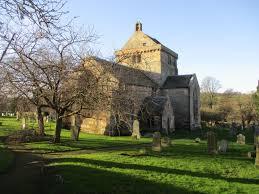
December 26th 1449 saw the first service held at Crichton Collegiate Church, south of Edinburgh.
The church lies a quarter-mile southwest of the Midlothian village of Crichton, and just to the north of Crichton Castle, the Crichton Parish Church was established as a Collegiate Church in 1449 by Sir William Crichton, laird of the nearby Crichton Castle and Chancellor of Scotland.
One of few remaining pre-Reformation collegiate churches which are still in use in Scotland, the Parish Church of St. Mary and St. Kentigern comprises a chancel and two transepts built in red sandstone; there was also probably a nave, but the only traces now are ragged stone work on either side of the entrance and traces of the roofline on the tower.
The vaulted interior was furnished during a major restoration completed in 1899, and it was then that the stained glass was installed.
Collegiate’ describes churches where priests and choirboys were recruited to pray daily for the souls of the great families who built and owned them.
20 notes
·
View notes
Text
what parts of the uk the marauders are from:
james- north england, maybe durham or a village nearby it
remus- wales, a small village fairly near newport (maybe llaanhennock or something)
sirius and regulus- south england, london (i cant remember whereabout in london grimmauld place is)
peter- southeast england, lives in a coastal town somewhere like sandgate
marlene- grew up in scotland but moved to the same town as james in north england when she was about 6
mary- southwest england, im thinking cornwall or devon
lily- scotland, a small town or village (fintry maybe)
dorcas- northern ireland, probably belfast
#release of the drafts!#marauders era#marauders#marauders headcanons#james potter#remus lupin#sirius black#regulus black#peter pettigrew#marlene mckinnon#mary macdonald#lily evans#dorcas meadowes
35 notes
·
View notes
Text
ROCKS
Hello again fellow bloggers,
The most amazing thing about nature for me is the geology of an area. My main fixation in general is pollinators, as exemplified by my group's podcast, “What the Buzz?” and I love bees and ants and stuff like that. However, anytime I'm out hiking or just exploring, I can't help but get excited about rocks. The geology and topography of an area tell a story that goes back millions of years. For instance, down where I'm from in Nova Scotia there is a place called the Bay of Fundy, I'm sure you've all heard f it considering it is home to the world's highest tides. Down near a little village named Walton there is a shale beach with a massive cliff and folds in the rocks.
This cliff face tells the story of two landmasses colliding together to form what is now Nova Scotia. Initially happening long before the Atlantic formed. And then the Bay of Fundy itself formed from the rifting of North America from Africa and Europe. This caused the split in the mountain chain that now has pieces in Morocco, Scotland, the USA, Canada, and Norway!
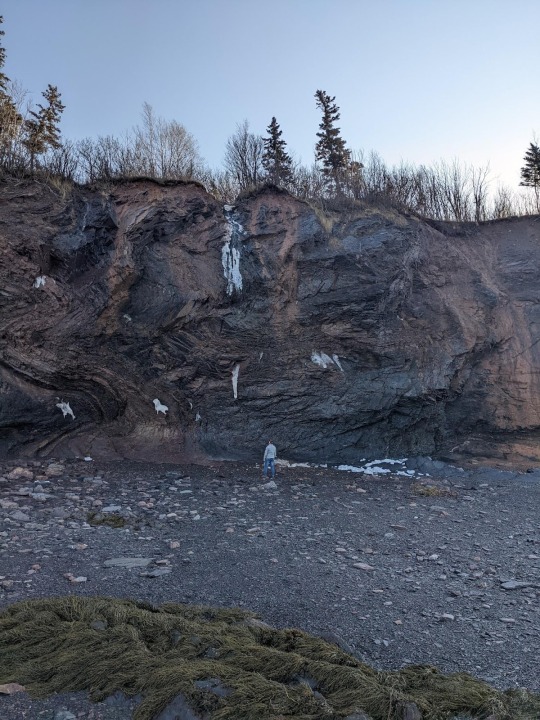
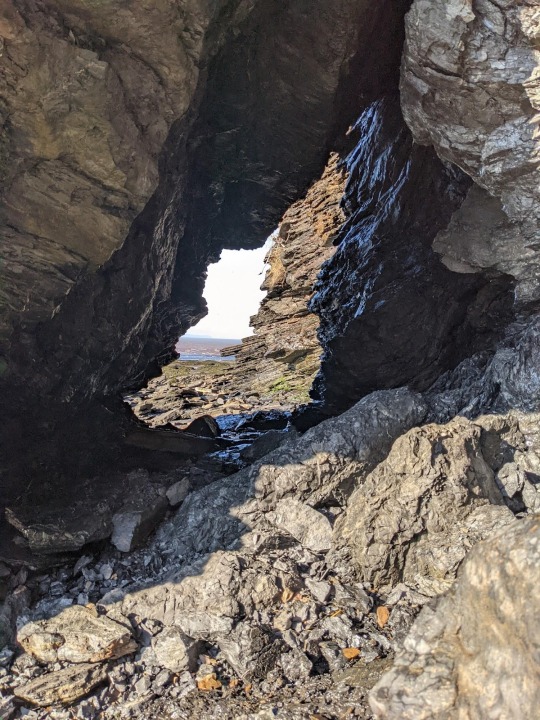
(pictures taken by me, Walton Cliffs)
A little closer to campus there is a location in Hamilton called the Devil's Punchbowl. I've gone there twice now for class field trips. The Devil's Punchbowl tells a story of the ancient seas and streams that used to run through this area of southwest Ontario. The grains of sand that make up the sandstone tell stories of millions of years ago. The dolomitic capstone of the Niagara Escarpment tells another story, so long as you speak the language of rocks and sediment.

(another photo by me, Devils Punchbowl)
Another area of Nova Scotia I've hiked through is on the Cape Split Peninsula. This region of the province is located on basaltic bedrock which formed during the same event that formed the Bay of Fundy. Magma pours out of the earth to form the north mountain range which makes up the sea sideward side of the Annapolis valley. The cape is covered in rocks filled with copper ore speckled through basaltic rock. Based on the patterns and the lack of crystallization you can tell that this magma cools very quickly, likely due to a rushing in of seawater after the rifting event.

(another photo by me, Cape Split Point)
Further up the bay, there are a few islands, near Parrsboro, the indigenous peoples of the area, the Mi’kmaq, called these the five islands. The five islands are part of the legends passed down by the Mi’kmaq people. The story goes that Kluskap, or Glooscap as the settlers called him, who was a giant man, was fighting a giant beaver in the bay. During the fight, Kluskap hurled 5 large boulders at the beaver that formed the islands today, the beaver was said to have been trapped by the boulders and sticks causing him to turn into gold underground. Geologically these islands are exposed parts of the north mountain chain that I talked about earlier but it's neat learning about the indigenous peoples’ folklore, especially when centered around how the landscape was formed.
Anyways, till next week bloggers!
4 notes
·
View notes
Note
hi, happy wbw!!
tell me about the climate in your world!! are the seasons anything like ours, or are they completely different? what is the weather like?
OH MY GOSH??? I have been sitting on this ask since... JULY??? What?? I AM SO SORRY. I think I was waiting until I got further into draft 3 of WIPVII because this is the draft where I planned to actually finalize these details.
I haven't heard from you in a while my friend, so maybe my answering this will summon you? please? Henry misses his number one fan<3
This WIP is very low fantasy - no magic, no mythical creatures, nothing that doesn't also exist in our world what so ever - so I got lazy and decided there was absolutely no reason I couldn't just make the climate/biome that the story takes place in very similar to the one I live in. The goods news is I can get really hyper-specific with the descriptions because I spent a lot of time in forest growing up. (It also makes the story feel more self-insert-y, which is always a plus hehe).
Flora
The only difference between the biome/ecosystems in this story and versus where I live IRL is that I live in North America and this story takes place in two-ish countries loosely inspired by England, Scotland, Wales, Breton, and Western France. The weather where I live is similar enough but I tried to only include plants that grow around my home that also grow in those regions of Europe (most are considered invasive species where I live - holly, ivy, broom, yew trees etc).
Seasons (temperature, daylight, rain, frost, leaf colours, lunar cycle)
To keep things consistent I decided just pretend that the lunar cycle in this world lined up with the lunar cycle in our world from September 15th, 2023 (a night with a new moon) to October 31st, 2023 (the hunter's moon). This way I could map out my plot on a calendar and make sure every time I describe a moon or tide it was in the right phase. It also helped me keep track of daylight hours and seasonal changes.
When the story starts, like the climate where I live, it is late summer and everything is yellow and tinder-dry. Then within a few days the rains start (beginning of fall) and come on and off every few days for the rest of the story. It'll rain fairly hard most of the day (there isn't a specific time of day that is more likely) and then it will stop as suddenly as it started.
The weather is warm at the beginning of the story. Warm enough that my main character, who has just swam through the ocean and is now wandering naked in a forest, is able to get dry pretty quick and is not at high-risk of hypothermia (everything is also so dry it is also easy for her to light a fire).
As the story progresses the days grow shorter, the leaves start to change and fall, the streams go from dried up to flooded, the berries shrivel up and rot, the temperature drops, and by the end of the story there is frost on the ground first thing in the morning. I think there the first snowfall happens in the very last scene... but I can't remember... I haven't read it in a while. If it does, the snow doesn't stick (just like home! *cries*)
Winds (and fog)
Most of the story takes place in a hilly region of woodland which is sandwiched between two mountain ranges (north to northwest and far north east), vast plains (east and north), an ocean straight (south), and open ocean (southwest). So there are some serious winds here and some of then occur daily like clockwork. I actually drew a map to help me keep track of them.
[I don't have my reference map with me as I type this so these might be inaccurate but to give you a sense:]
First thing in the morning a shrill wind and fog roll off the open sea (from the southeast).
Around midmorning as the air warms a second, warmer wind, comes in from the southern straight.
There's a midafternoon chill which is actually a very gentle wind caused by sunlight cooling in the shadow of the northwestern mountains.
Then there is an evening wind from the northeast which is much stronger, having picked up momentum on the plains.
Sometime in early October a really strong, harsh wind also arrives from due north where it has been able to pick up a lot of momentum travelling over the steppes. When that wind comes it basically stays for weeks and doesn't stop blowing.
All these winds (and the fog) are inspired by winds that exist around where I live. But are exacerbated by the plains and the mountains. (There are mountains where I live but they aren't as close by). There aren't really any plains until the other side of the Rockies... which is a whole province away. But there are a lot of hills and small mountains.
Thanks, as always, for the ask, friend<333
4 notes
·
View notes
Text
Season of the Witch
- The origins (and places) of the Cailleach
The Cailleach, divine Hag/Crone of Gaelic folklore, is often portrayed as the embodiment of Winter. She is said to appear as the earth is dying, and is known as a bringer of storms. She is said to control the weather and determine the length of Winter and its harshness.
She is also said to be responsible for the formation of many of the country’s most prominent landmarks, and there are probably more geographical and archaeological features on the Irish landscape, that are associated with the Cailleach, than any other character in Irish folklore (see pics for landmarks & associations).
As a creator of the land and controller of the weather, the Cailleach would appear to represent an archetypal sovereignty/land goddess, whose origins may be traced back to Bronze-Age, or even Neolithic cosmologies.
However, despite her presence on the landscape, the Cailleach does not appear in ANY of the Irish literary myths. In fact, most of the traditions we now associate with the Cailleach (such as her association with winter), can only be traced back as far as the late-19th Century Gaelic revival in Scotland, where she features much more prominently than in Irish folklore.
Her earliest appearance in any written form is in an ‘untitled’ poem from a 16th Century manuscript (though its language suggests some of it was written at a much earlier date - possibly 10th Century) which, after it was first translated in 1899, has come to be known as ‘The Lament of the Old Woman of Beare’.
In the poem, the woman (name unknown) describes herself as an aging Queen of the Beara Peninsula in southwest Ireland; lamenting the passing of her youth and the riches and attention that went with it. The poem’s essentially christian narrative holds no hope of redemption or regeneration for the the old woman or the ‘old ways’ that she seems to represent.
Although the poem is untitled, the original introduction line reads… “Sentainne Bérri Cecenit íarna senad don chríni” (The Old Woman of Beare said this when senility had aged her).
The Old-Irish word ‘Sentainne’ meaning ‘Old-Woman’ would come to be replaced in later Middle-Irish with the word ‘Caillech’ - which in Old-Irish means “the veiled one” (specifically a ‘Nun’) but by the 10th Century, had come to signify any woman beyond childbearing years (which was OLD in those days).
The Old Irish ‘caillech’ ('veiled one'), from Old Irish ‘caille’ (‘veil/cloak’) is generally thought to be a loan-word from the Latin ‘pallium/palli(i)’ meaning ‘cover’ or ‘cloak’ (usually in reference to religious vestments - hence the 'nun' translation).
If so, this would make the Cailleach a ‘relative’ newcomer (etymologically speaking), which has led many medievalist academics to propound that she is an early-medieval folk figure rather than an ancient divinity (no surprise there !). . . However, this could be yet another ‘folk-etymology’ - where the meaning of a word changes due to a popular misconception regarding its origins.
Classical writings indicate that the “Cailleach” may have been known as early as the 5th Century BC; in the area known today as Galicia, which gets its name from a Celtic tribe known as the Callaeci. This tribe on the north-west of the Iberian Peninsula were first named as the ‘Kallaikoi’ by the Greek historian Herodotus in the 5th Century BC; before being Latinised by Roman writers to ‘Callaeci’ in the 2nd Century BC - a name which Ptolemy suggested as meaning ‘worshippers of the Callaec’.
Interestingly, in Spanish folklore, another name for Galicia is "Terra Meiga" (Land of the Witches).
Given that recent archaeological, linguistic and genetic evidence points to a migration into Ireland by ‘Proto-Indo European/Proto-Celtic’ speakers during the Bronze-Age (c.2000 BCE); rather than the traditional view of a later migration of ‘Celtic/Old Irish’ speakers during the Iron-Age, (c.500-100 BCE): It seems unlikely that the word(s) ’caillech/caille’ would be ‘borrowed’ from Latin into Irish at such a late date.
Both Italic (Latin) and Celtic (Irish) are closely related branches of the Indo-European language family; with both languages diverging from the original Proto Indo-European (PIE) language sometime after 2000BCE (The similarity between the Celtic & Italic languages has even led some scholars to believe that there was a Proto Italo-Celtic language spoken prior to their divergence from each other).
Therefore, it now seems likely that the word ‘caille’ derives directly from the PIE root word, *kel- meaning ‘to conceal/hide/cover’.
However. *kel- is also the root of another PIE word - *Kolyo - meaning ‘the coverer’, which is thought to describe a (hypothetical) goddess who is half maiden / half grotesque, governing the realm of death, but also the life which is sustained by death… sound familiar?
It is therefore possible that the modern Cailleach is a variation of this ancient female deity/character (*Kolyo), brought here in the Bronze Age by the same Indo-European speakers, from whom the peoples of Ireland and Scotland are descended ?
- Jane Brideson
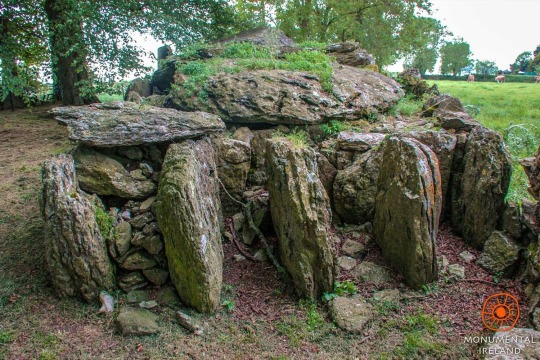
The Labbacallee (Hag’s Bed) Wedge Tomb in Co. Cork is said to be another of the Cailleach’s dwellings; which in this instance, she shared with her husband, the druid Mog Roith. Local folklore tells us that during an argument, a huge rock lying in the nearby river was thrown by the Cailleach at her fleeing husband, pinning him to the riverbed. . .
#Cailleach#ancestors alive!#what is remembered lives#memory & spirit of place#ancient ways#sacred ways#folkways#traditions#old woman#crone#wisewoman#hag#Irish#megalithic#ancient history#Celtic#galicia#iberia#ireland#scotland#folklore#myth
9 notes
·
View notes
Text
Archaeologists working on the Isle of Arran have begun to reveal the secrets of Scotland’s first farmers through the excavation of a 1.1 km Neolithic cursus which they believe led to the stunning stone monuments of the island.
14 notes
·
View notes
Photo






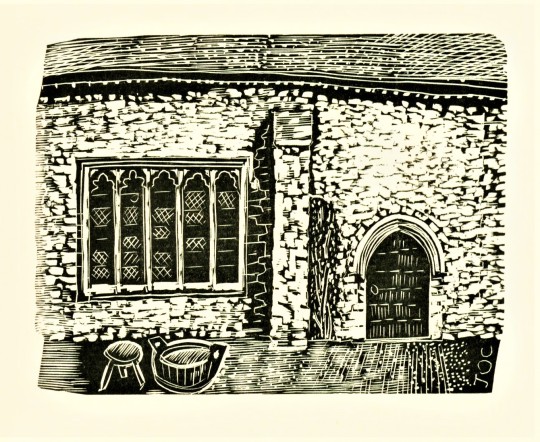



Wood Engraving Wednesday
JOHN O’CONNOR
We return to engravings by the English wood engraver John O’Connor (1913-2004) published in People & Places, printed in 1999 by John and Rosalind Randle’s Whittington Press in Herefordshire, England in an edition of 375 copies. John O’Connor’s career spanned over six decades, beginning with engravings for an edition of Joan Rutter's poems Here's Flowers in 1936.
The wood engravings in People & Places are a compilation of engravings he created to illustrate a column in Richard Ingrams’s Oldie magazine. O'Connor produced a wood-engraving every month for the magazine from 1992 to 2001, just three years before his death. Even at the end of his career, O’Connor maintained his creative energy despite using a wheelchair and suffering from increasing deafness. In his obituary, The Guardian noted that O’Connor’s work,
is filled with a profound - almost romantic - love of the natural world. He had a pastoral vision, albeit one imbued with melancholy, at the passing of time and a changing world.
He saw his favourite painting places in Suffolk - the ponds, willows, briars and honeysuckle - disappear beneath the bulldozer and combine harvester, and eventually moved with his wife to the emptier spaces of southwest Scotland.
Tap on the images to see the titles.
View more posts from People & Places.
View all posts with engravings by John O’Connor.
View more posts related to the Whittington Press.
View more posts with wood engravings!
#Wood Engraving Wednesday#wood engravings#wood engravers#John O'Connor#People & Places#Whittington Press#John and Rosalind Randle#Richard Ingrams#The Oldie#letterpress printing#fine press books
83 notes
·
View notes
Text
Audiodrama Saturday rather than Sunday this week...
...because I'm fleeing to Scotland again tomorrow....spoilers will follow.
Finished Leviathan Chronicles and was very sad about Evangeline. I then kept getting Leviathan adverts on other podcast feeds and being sad about Evangeline again.
E27 of Proserpina Park did not shy away from portraying Tanukis in all their glory unlike those testicle-cowards who did the English version of Pom Poko. Let 👏Tanukis👏 Have👏 Magic 👏Balls.🦝🦝🦝
Disappointed the hirsute fellow from Lancaster on Monstrous Agonies 103 isn't real, he sounds lovely. Would absolutely pop across the Pennines for a date.
Speaking of the North, I binged all of Don't Mind Cruxmont and..where is Cruxmont? It sounds like it's about an hour's drive from me in Southwest County Durham. (I am not allowed to go driving down the A66 looking for the weird plum village.) Anyway, this show had intensely emotive scenes, intriguing plot and also mycology, of which I approve.
Been on a bit of a Fool and Scholar binge, you may be able to tell. Dark Dice was great, harsh but also adorable in places, Boar Knight S1 is finished. That final song had me tearing up. 😭
If you made it to the end of another of my infodumps, friend Leanne is crowdfunding for Tell no Tales! I need more wholesome ghosts, plz yeet them a dolla if you can.
#leviathan chronicles#Proserpina Park#monstrous agonies#Don't mind cruxmont#Dark Dice#The Boar Knight#tell no tales#audiodrama#audiofiction#audio drama sunday
12 notes
·
View notes
Text

Rock Facts: Fun With Faults
I actually had this post in mind a couple of weeks ago, but then I got up on the 9th and decided that it... might be considered in poor taste that particular weekend. So I gave it a little while.
So, when you think of seismically-active regions, you generally think of places like California and Japan; Scotland is not very high on the list of places that spring immediately to mind. In fact, we get quite a lot of earth tremors every year! It's just that fortunately most of them are small enough that nobody who isn't staring intently at a seismograph at the time even notices, and most of the bigger ones are on the scale of 'huh, that must've been a big truck that just went past'.
There are three main fault zones (and a lot of smaller ones) running through Scotland to cause these little quakes, and interestingly you can see them pretty clearly on the satellite picture above.
The first I'll highlight is the Great Glen Fault.

It's a strike-slip fault (goes sideways) like San Andreas in California, though thankfully much less active, and runs from the Isle of Mull in the southwest to the Moray Firth in the northeast. The fault actually extends further in either direction, down through the north of Ireland and up towards Shetland, but those regions have different names so we won't worry about them not.
The fault leaves a particular line of weakness in the bedrock along the Great Glen that's been further scoured out by glacial activity; this is why Loch Ness is as deep as it is. It's not the biggest loch by surface area (that would be Loch Lomond) and it's not the deepest (Loch Morar), but the two combined make it easily the biggest by volume. As in, 'contains more freshwater than all the lakes in England and Wales combined'.
The Kessock Bridge, which you'll cross to drive north out of Inverness, is engineered to account for movement on the fault.
Secondly, the Southern Uplands Fault.
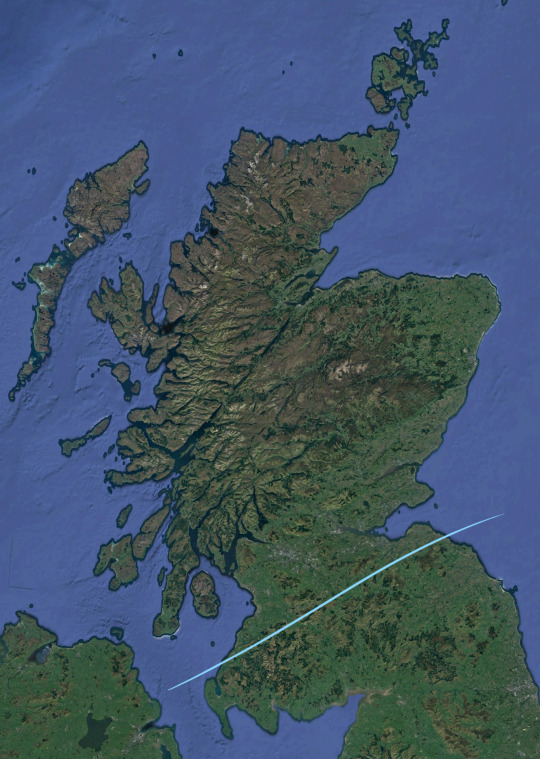
This one cuts across from South Ayrshire in the southeast to Dunbar in East Lothian. I actually don't know very much about it, but it's the divider between the gentle lowlands of the Central Belt and the higher ground of the Southern Uplands. Nice part of the country, actually.
Finally, the one I find most interesting: the Highland Boundary Fault.
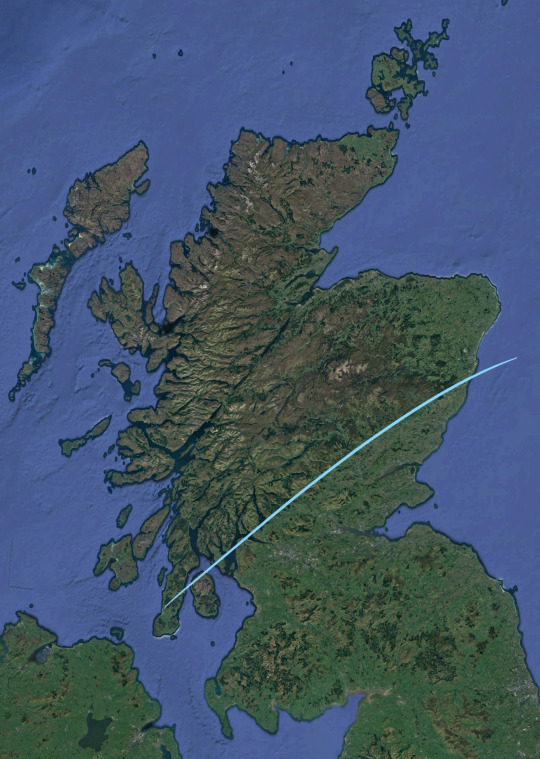
Look back up at the unedited sat pic; you can see that it makes a very, very clear line from the Isle of Arran in the southwest, up across the southern end of Loch Lomond and through Perthshire, until it hits the coast again at Stonehaven just south of Aberdeen. The political and cultural dividers between the Highlands and the Lowlands are more complicated and outwith the scope of this post, but geologically? This is the boundary.
On the way, the fault passes through the small town of Comrie to the west of Perth, where it shoogles enough to make Comrie the most seismically-active place in Britain and give it the nickname of the Shaky Toun. It's also the site of the first modern seismometer, which was kept in the small building known as Earthquake House. Earthquake House is still a seismic observatory, though the equipment is a bit better these days.
6 notes
·
View notes
Text
Thanks for the tag @emotionalcadaver!
Questions...
What is a bad habit you have? more than I'd like but just vegging out thinking about doing things instead of actually doing them
- What’s your dream job? theater actress or playwright
- How many times have you been pulled over by a cop? 5, but I don't always get ticketed :3
- Dream travel destinations? Tokyo, Scotland, Greece, The American Southwest
- What are the top two words your friends would use to describe you? Sinnamon Roll
- Favourite beverage? a nice and spicy chai latte
- Are you more independent, or need lots of people around you? it varies but lean towards more independent
No pressure tags: @chadillacboseman, @roofgeese, @spacestephh, @quantum-lover, @illmetbymoonlight, @socially-awkward-skeleton, @mintspider
4 notes
·
View notes
Text



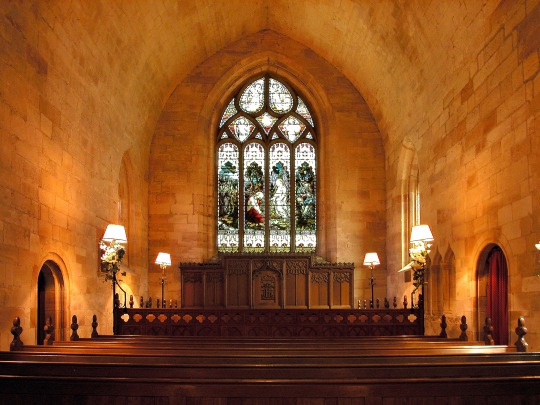


On 26th December 1449 the first service was held at Crichton Collegiate Church, south of Edinburgh.
The church is one of few remaining pre-Reformation collegiate churches which are still in use in Scotland, Rosslyn Chapel, also in Midlothian being another.
Lying a quarter-mile southwest of the Midlothian village of Crichton, and just to the north of Crichton Castle, the Crichton Parish Church was established as a Collegiate Church in 1449 by Sir William Crichton, laird of the nearby Crichton Castle and Chancellor of Scotland.
Crichton is named after its lords, even though the “Lords” of Crichton were members of the ranks of the lesser mobility, until 1424, when William was knighted at the coronation of James I. His family fortunes were raised by his son, William, the Lord Chancellor of Scotland, who became, during the minority of James II, the most powerful person in the kingdom.
William Crichton spent much of his life quarrelling with the powerful Douglases. Crichton was responsible for the famous “Black Dinner” in Edinburgh Castle at which the Sixth Earl of Douglas and his brother were murdered.
As a consequence of the damage to the castle, William, who became Lord Chancellor in 1447, had to effect repairs. While he was at it, he decided to build Crichton Collegiate Church.
Confirmation of the status of a collegiate church was given by James Kennedy, Bishop of St. Andrews, and the church was finished in time to hold its first service on December 26th 1449, making it just a few years older than Midlothian’s other famous old kirk, the Collegiate Chapel of St Matthew, better known now as Rosslyn Chapel.
At its inauguration, provisions had been made for a provost, eight prebendaries, two boys or clerks and a sacrist. The money to sustain this religious community was coming from the revenue of neighbouring churches, and elsewhere.
The Reformation of 1560 swept away the system of collegiate churches in Scotland. By the time the new owners embarked on a major programme to rebuild Crichton Castle in the 1580s, the chapel was already in a state of disrepair. Still, in 1641, the church formerly known as collegiate became Crichton’s Presbyterian parish church.
In the 19th century, the future of Crichton looked equally bleak. In 1822, it was decided that repairs had to be carried out imminently, or, it was suggested, perhaps it was better to abandon the chapel altogether – underlining the desperate state in which the building was found to be in. It was nevertheless decided that repairs should be carried out, which occurred in 1825.
The church, now without its original nave, saw a pulpit placed high on the south wall (a ring in the wall is today the only remnant of it), and with the extensive use of galleries around three walls, as many as 600 people could be seated in what must have been a very cramped space when full.
Despite these renovations, in the late 19th century, further repairs and renovations had to be carried out. In 1898, when all “innovations” were cleared out, only leaving the bare and solid walls. The church reopened on May 11, 1899. The latest series of restoration work was carried out in 1999, to coincide with the church’s 450th anniversary.
51 notes
·
View notes
Text
What Should I Write Next?
Thank you to everyone for your very kind words on the conclusion of Don’t Let Me Fall. Since I managed to wrap that story up before the holidays, and since we’re due for the first big snowstorm of the season that will keep me indoors all weekend, I’m trying to decide what to write next.
I am not promising to write the most popular choice, but I am interested to know how readers feel about the following contenders:
Dal Riada (working title) - a WIP that is a retelling of Outlander with Claire falling from the 1860s back to the proto-Gaelic kingdom of Dalriada in 806, where Seumas (Jamie) is the nephew of the king. It also tells the story behind the Woman of Balnain folktale that Claire hears sung in Outlander. Omniscient POV. I’ve written 6 chapters (about 19,000 words) and done a ton of historical research, but I need to revisit the plot and do a significant re-write of what’s there. This is the story I most want to write, but it will take a looong time to do it justice. Likely completion: Summer 2023.
Laredo (working title) - a WIP set in the American southwest in the 1980s. Jamie is a vaquero (Spanish-American cowboy) on his family’s ranch in southern Texas when Dr. Claire Beauchamp’s car breaks down in his one-saloon town. He’s a fugitive from the law, she’s running away from financial and personal ruin, and they come to each other’s aid. Claire POV. This is the story closest to completion. I’ve got 13 chapters (about 37,000 words) written, and there’s just one major plot hole to fill and a lot of polishing before it’s done. Likely completion: January/February 2023.
West End Girl - a WIP set in mid-1980s London during the height of the cocaine/heroin epidemic. Claire is a wealthy Mayfair society girl who witnesses something she shouldn’t. Jamie is the leader of a Docklands street gang called the Clan who protects Claire from Black Jack Randall, her boyfriend’s cousin. It’s a lot darker than my usual stuff. Omniscient POV. This one is about half-written (12,000 words) but still needs some plotting and some rework as well. Likely completion: March 2023.
The Man from Black Water - another wacky fic idea that came to me not long ago. A cross-over between Outlander and the 1980s movie The Man from Snowy River, retold in 1880s Scotland rather than 1880s Australia. The plot would be almost identical to the movie (for those that have seen it) and I can practically recite that movie from memory, so this is a quick hit of feel-good fic. Likely completion: January/February 2023.
24 notes
·
View notes